Trimble Navigation XDLM UHF Transceiver Module User Manual XDL MicroIntegratersGde 03 12 indd
Trimble Navigation Ltd UHF Transceiver Module XDL MicroIntegratersGde 03 12 indd
Contents
- 1. Users Manual Part One
- 2. Users Manual Part Two
Users Manual Part Two

1XDL Micro Intergrator’s Guide
XDL Micro
Integrator’s Guide

2XDL Micro Intergrator’s Guide
Contact Information
Customer support and sales contacts
Quality, technology, and service are the hallmarks of Paci c Crest. We
provide easy access to our customer service department to keep you
running e ciently.
Headquarters EMEA Offi ce
Paci c Crest HAL Trade Center
510 DeGuigne Drive Bevelandseweg 150
Sunnyvale, CA 94085 1703 AX Heerhugowaard
U.S.A e Netherlands
Tel: 1-800-795-1001 (U.S.A toll free) Tel: +31-72-5348408
(408) 481-8070 (outside the U.S.A) Fax: +31-72-5348288
Fax: (408) 481-8984
Sales email: sales@Paci cCrest.com
Support email: support@Paci cCrest.com
Repair info: pccservice@Paci cCrest.com
Web www.Paci cCrest.com
Support hours are 8 am to 5 pm Paci c Time. Please visit our website for
up-to-date news and product announcements. Firmware and software
upgrades are available from our website, usually free of charge.
Legal notices
© 2012 Paci c Crest. All rights reserved. Adaptation, or translation of
this manual is prohibited without prior written permission of Paci c
Crest, except as allowed under the copyright laws. is document
contains proprietary information that is protected by copyright. All
rights reserved. e information contained in this document is subject
to change without notice.
PORON is a licensed trademark of Rogers Corporation. SATEL is a
registered trademark of SATEL Oy. Trimble is a trademark of Trimble
Navigation Limited, registered in the United States and in other
countries. TRIMMARK and TRIMTALK are trademarks of Trimble
Navigation Limited. Microsoft, Windows, and Windows Vista are either
registered trademarks or trademarks of Microsoft Corporation in the
United States and/or other countries. All trademarks are the property
of their respective owners.
Release notice
is is the March 2012 release of the XDL Micro Integrator’s Guide.
Warranty
PACIFIC CREST MAKES NO WARRANTY OF ANY KIND WITH REGARD
TO THIS MATERIAL, INCLUDING, BUT NOT LIMITED TO, THE IMPLIED
WARRANTIES OF MERCHANTABILITY AND FITNESS FOR A PARTICULAR
PURPOSE. Paci c Crest shall not be liable for errors contained herein or
for incidental consequential damages in connection with the furnishing,
performance, or use of this material.
Warranty
One-Year limited warranty
is warranty gives you speci c legal rights. You may also have other
rights which vary from state to state or area to area.
Paci c Crest warrants XDL family products, inclusive of cables and
batteries, against defects in materials and workmanship for a period of
one year from receipt by the end-user.
Exclusions
Should Paci c Crest be unable to repair or replace the product within a
reasonable amount of time, a refund of the purchase price may be given
upon return of the product.
e warranty on your radio shall not apply to defects resulting from:
• Improper or inadequate maintenance by the customer
• Unauthorized modi cation, negligence, or misuse
• Operation outside of the environment speci cations
Warranty limitations
is warranty set forth above is exclusive and no other warranty,
whether written or oral, is expressed or implied. Paci c Crest speci cally
disclaims the implied warranties of merchantability and tness for a
particular purpose.
Notices
Class B Statement – Notice to Users. is equipment has been tested and
found to comply with the limits for a Class B digital device, pursuant to
Part 15 of the FCC rules. ese limits are designed to provide reasonable
protection against harmful interference in a residential installation.
is equipment generates, uses, and can radiate radio frequency energy
and, if not installed and used in accordance with the instructions, may
cause harmful interference to radio communication. However, there is
no guarantee that interference will not occur in a particular installation.
If this equipment does cause harmful interference to radio or television
reception, which can be determined by turning the equipment o and
on, the user is encouraged to try to correct the interference by one or
more of the following measures:
• Reorient or relocate the receiving antenna.
• Increase the separation between the equipment and the receiver.
• Connect the equipment into an outlet on a circuit di erent from
that to which the receiver is connected.
• Consult the dealer or Paci c Crest directly for help.
Changes and modi cations not expressly approved by the manufacturer
or registrant of this equipment can void your authority to operate this
equipment under Federal Communications Commission rules.
Canada
is digital apparatus does not exceed the Class B limits for radio noise
emissions from digital apparatus as set out in the radio interference
regulations of the Canadian Department of Communications.
Le présent appareil numérique n’émet pas de bruits radioélectriques
dépassant les limites applicables aux appareils numériques de Classe B
prescrites dans le règlement sur le brouillage radioélectrique édicté par
le ministère des Communications du Canada.
Europe
is product has been tested and found to comply with the requirements
for a Class B device pursuant to European Council Directive 1999/5/
EC on R&TTE, thereby satisfying the requirements for CE Marking and
sale within the European Economic Area (EEA). ese requirements are
designed to provide reasonable protection against harmful interference
when the equipment is operated in a residential or commercial
environment, and to ensure that the equipment is safe.
Australia and New Zealand
is product conforms with the regulatory requirements of the
Australian Communications and Media Authority (ACMA)
EMC framework, thus satisfying the requirements for C-Tick
Marking and sale within Australia and New Zealand.
Notice to Our European Union Customers
For product recycling instructions and more information,
please go to www.trimble.com/ev.shtml.
Recycling in Europe: To recycle Trimble WEEE (Waste
Electrical and Electronic Equipment, products that run on electrical
power.), Call +31 497 53 24 30, and ask for the “WEEE Associate”. Or,
mail a request for recycling instructions to:
Trimble Europe BV
c/o Menlo Worldwide Logistics
Meerheide 45
5521 DZ Eersel, NL
Compliance
e XDL Micro is designed to be compliant with worldwide regulatory
requirements, including FCC part 90, ETS 300-113-2, IC RSS 119 and
others.
WARNING – The XDL Micro is classified as an intentional
radiator of type radio. Conducted and radiated emissions of
the standard XDL Micro do not exceed the requirements of
FCC part 90 and ETS 300-113-2. OEM is responsible for full
compliance of final product.

3XDL Micro Intergrator’s Guide
Safety Information
Before you use your radio, ensure that you have read and understood this publication, as
well as safety requirements.
CAUTION – A license is required before operating radio communication equipment.
Warnings and cautions
An absence of specific alerts does not mean that there are no safety risks involved.
Always follow the instructions that accompany a Warning or Caution. The information
they provide is intended to minimize the risk of personal injury and/or damage to the
equipment. In particular, observe safety instructions that are presented in the following
formats:
WARNING – A Warning alerts you to a likely risk of serious injury to your person and/
or damage to the equipment. A warning identifies the nature of the risk and the extent
of possible injury and/or damage. It also describes how to protect yourself and/or the
equipment from this risk. Warnings that appear in the text are repeated at the front of the
manual.
CAUTION – A Caution alerts you to a possible risk of damage to the equipment and/or loss of
data. A Caution describes how to protect the equipment and/or data from this
Exposure to radio frequency energy
The radio is designed to comply with the following national and international standards
and guidelines regarding exposure of human beings to radio frequency electromagnetic
energy, in addition to protection against harmful interference of neighboring electrical
equipment:
• FCC Report and Order FCC 96-326 (August, 1996)
• American National Standards Institute (C95.3-1992)
• National Council on Radiation Protection and Measurement (NCRP - 1986)
• International Commission on Non-ionizing Radiation Protection (ICNRP - 1986)
• European Committee for Electrotechnical Standardization (CENELEC)
• FCC CFR47 Part 15
• FCC CFR47 Part 90
• Industry Canada RSS 119
• ETSI EN 300 113-2
• ETSI EN 300 489
• ACA AS/NZS 4295
• iDA Spec 111
• OFTA STD-1E
• RRC CMII
Contact your sales representative for model specific country approval.
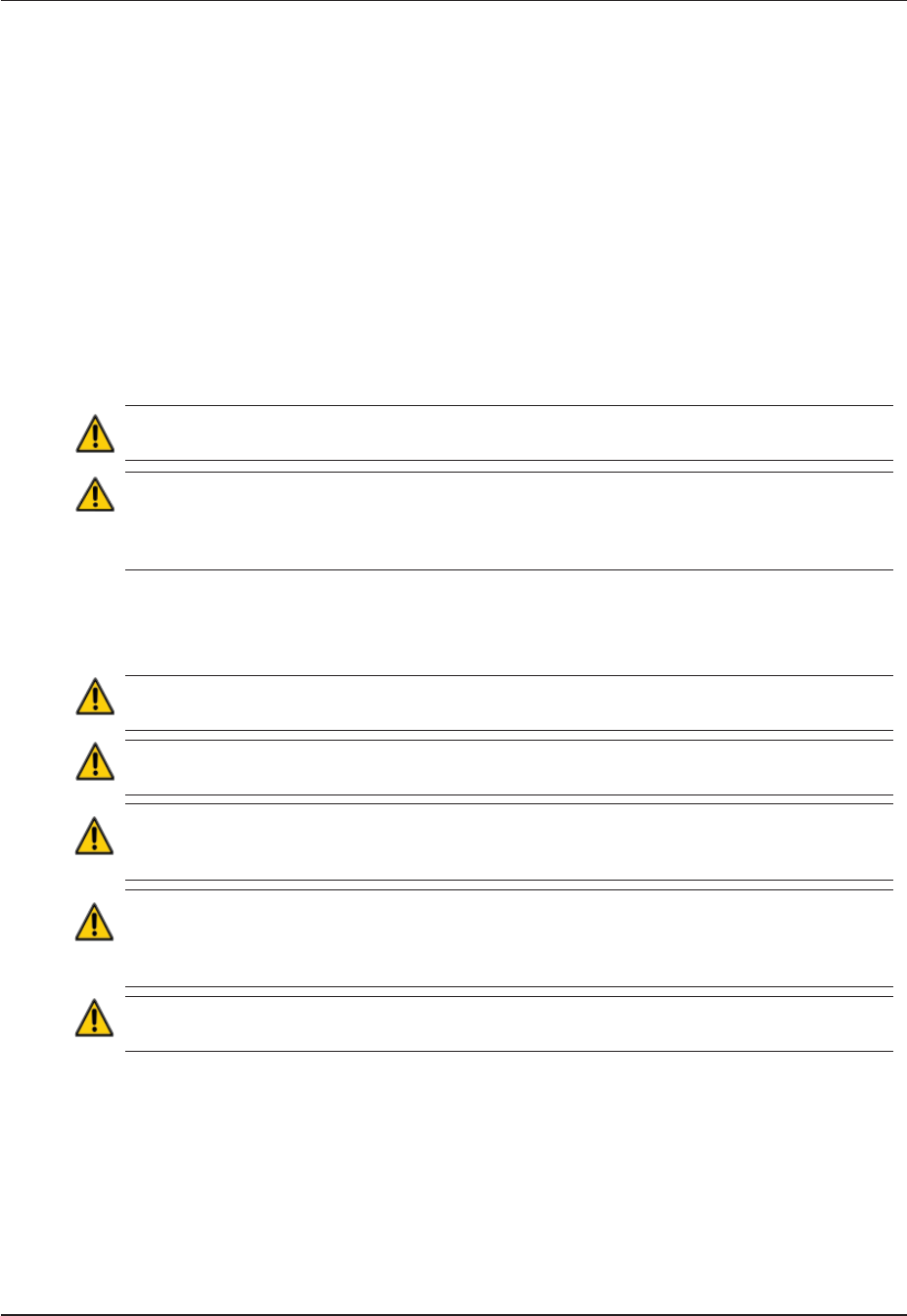
4XDL Micro Intergrator’s Guide
To assure optimal radio performance and to ensure that exposure to RF energy is within
the guidelines in the above standards, observe the following operating procedures:
• Do not operate a transceiver when someone is within the distance noted below of the
antenna (unity gain).
–45 cm (approximately 12 in) for the XDL Micro radio @ 2 W
–15 cm (approximately 6 in) for the XDL Micro radio @ 1 W
• Do not operate the transceiver unless all RF connectors are secure and any open
connectors are properly terminated.
• Avoid contact with the antenna while operating the transceiver.
• Do not operate the transceiver with a damaged antenna. If a damaged antenna comes
in contact with the skin, a minor burn may result.
• Do not operate the equipment near electrical blasting caps or in an explosive
atmosphere.
CAUTION – Changes or modifications not expressly approved by the FCC could void the user’s
authority to operate the equipment.
WARNING – The XDL Micro is classified as an intentional radiator of type radio transceiver.
Conducted and radiated emissions of the standard XDL Micro do not exceed the
requirements of FCC part 90 and ETS 300-113-2. OEM is responsible for full compliance of
final product.
General cautions
CAUTION – You must handle the XDL Micro with care during installation. Remove the
transceiver from its protective bag only in an ESD safe area.
CAUTION – Incorrect impedance matching of the antenna, connectors, or cable degrades the
performance of the transceiver.
CAUTION – Internal circuitry protects the inputs and outputs against damage caused by
high static voltages or electric fields. However, normal precautions are necessary to avoid
application of any voltage higher than the maximum-rated voltages.
CAUTION – Radiated and conducted signals to and from the transceiver may cause problems
due to interference. Correct attention to frequency planning may reduce interference from
radiated or conducted frequencies that fall within the pass-bands of the filters at the IF
frequencies.
CAUTION – To avoid interference between the signals, Pacific Crest recommends you do not
bundle the antenna interface cable with other signal cables internal to your product.

5XDL Micro Intergrator’s Guide
Contents
Safety Information . . . . . . . . . . . . . . . . . . . . . . . . . . . . . . . . . . . . . . . . . . . . . . . . . . . . . . 3
Introduction . . . . . . . . . . . . . . . . . . . . . . . . . . . . . . . . . . . . . . . . . . . . . . . . . . . . . . . . . . . 6
Getting Started. . . . . . . . . . . . . . . . . . . . . . . . . . . . . . . . . . . . . . . . . . . . . . . . . . . . . . . . . 7
Interface Port Pin Out . . . . . . . . . . . . . . . . . . . . . . . . . . . . . . . . . . . . . . . . . . . . . . . . . . . . . . . . . . . . . . . . . . . . . 8
Transmit and receive pins. . . . . . . . . . . . . . . . . . . . . . . . . . . . . . . . . . . . . . . . . . . . . . . . . . . . . . . . . . . . . . . . . . 9
Antenna port . . . . . . . . . . . . . . . . . . . . . . . . . . . . . . . . . . . . . . . . . . . . . . . . . . . . . . . . . . . . . . . . . . . . . . . . . . . . . . 9
Compatibility. . . . . . . . . . . . . . . . . . . . . . . . . . . . . . . . . . . . . . . . . . . . . . . . . . . . . . . . . . . . . . . . . . . . . . . . . . . . . . 9
Protocols and Operation Modes . . . . . . . . . . . . . . . . . . . . . . . . . . . . . . . . . . . . . . . . . . 10
Electrical Considerations . . . . . . . . . . . . . . . . . . . . . . . . . . . . . . . . . . . . . . . . . . . . . . . . 11
Power supply . . . . . . . . . . . . . . . . . . . . . . . . . . . . . . . . . . . . . . . . . . . . . . . . . . . . . . . . . . . . . . . . . . . . . . . . . . . . . . . . 11
Data interface . . . . . . . . . . . . . . . . . . . . . . . . . . . . . . . . . . . . . . . . . . . . . . . . . . . . . . . . . . . . . . . . . . . . . . . . . . . . . . . 11
CMOS input/output protection circuitry . . . . . . . . . . . . . . . . . . . . . . . . . . . . . . . . . . . . . . . . . . . . . . . . . . . . . 11
NC pins . . . . . . . . . . . . . . . . . . . . . . . . . . . . . . . . . . . . . . . . . . . . . . . . . . . . . . . . . . . . . . . . . . . . . . . . . . . . . . . . . . . . . . 11
Power down pin. . . . . . . . . . . . . . . . . . . . . . . . . . . . . . . . . . . . . . . . . . . . . . . . . . . . . . . . . . . . . . . . . . . . . . . . . . . . . . 12
Error codes . . . . . . . . . . . . . . . . . . . . . . . . . . . . . . . . . . . . . . . . . . . . . . . . . . . . . . . . . . . . . . . . . . . . . . . . . . . . . . . 12
Shielding considerations. . . . . . . . . . . . . . . . . . . . . . . . . . . . . . . . . . . . . . . . . . . . . . . . . . . . . . . . . . . . . . . . . . 12
Frequency planning . . . . . . . . . . . . . . . . . . . . . . . . . . . . . . . . . . . . . . . . . . . . . . . . . . . . . . . . . . . . . . . . . . . . . . 13
Mechanical Considerations . . . . . . . . . . . . . . . . . . . . . . . . . . . . . . . . . . . . . . . . . . . . . . 14
EMI interferers. . . . . . . . . . . . . . . . . . . . . . . . . . . . . . . . . . . . . . . . . . . . . . . . . . . . . . . . . . . . . . . . . . . . . . . . . . . . . . . 14
Shock and vibration . . . . . . . . . . . . . . . . . . . . . . . . . . . . . . . . . . . . . . . . . . . . . . . . . . . . . . . . . . . . . . . . . . . . . . . . . . 14
ermal transfer . . . . . . . . . . . . . . . . . . . . . . . . . . . . . . . . . . . . . . . . . . . . . . . . . . . . . . . . . . . . . . . . . . . . . . . . . . . . . 14
Materials. . . . . . . . . . . . . . . . . . . . . . . . . . . . . . . . . . . . . . . . . . . . . . . . . . . . . . . . . . . . . . . . . . . . . . . . . . . . . . . . . . . . . 14
Appendix A: Mounting Guide . . . . . . . . . . . . . . . . . . . . . . . . . . . . . . . . . . . . . . . . . . . . 15
Standard enclosure. . . . . . . . . . . . . . . . . . . . . . . . . . . . . . . . . . . . . . . . . . . . . . . . . . . . . . . . . . . . . . . . . . . . . . . . . . . 15
Appendix B: Cables and Connectors . . . . . . . . . . . . . . . . . . . . . . . . . . . . . . . . . . . . . . . 17
Value-added cable products . . . . . . . . . . . . . . . . . . . . . . . . . . . . . . . . . . . . . . . . . . . . . . . . . . . . . . . . . . . . . . . . . . 17
Interface connector . . . . . . . . . . . . . . . . . . . . . . . . . . . . . . . . . . . . . . . . . . . . . . . . . . . . . . . . . . . . . . . . . . . . . . . . . . 17
RF connector. . . . . . . . . . . . . . . . . . . . . . . . . . . . . . . . . . . . . . . . . . . . . . . . . . . . . . . . . . . . . . . . . . . . . . . . . . . . . . . . . 17
Appendix C: Technical Specifi cations . . . . . . . . . . . . . . . . . . . . . . . . . . . . . . . . . . . . . . 18
Appendix D: API Commands . . . . . . . . . . . . . . . . . . . . . . . . . . . . . . . . . . . . . . . . . . . . . 19

6XDL Micro Intergrator’s Guide
Introduction
This manual describes how to integrate the XDL Micro UHF transceiver (model numbers
XDLM-0, XDLM-1 and XDLM-2) into your product. Pacific Crest recommends that you
also read the XDLCONF User’s Guide for general information about configuring XDL
Micro modems, and for detailed programming information.
The XDL Micro is a general-purpose transceiver. It is compatible with the Pacific Crest
ADL, PDL and RFM product families of radio modems. It is also compatbile with radios
configured to use the SATEL®, South, Stonex Type 1, and Trimble TRIMTALK™ and
TRIMMARK™ protocols. The XDL Micro transceiver is designed specifically for integration
into new or existing products. Its small size, light weight, and power efficient operation
provide superior performance in embedded systems.
Legal restrictions
The XDL Micro transceiver may be programmed to transmit only in accordance with a
license issued by the radio authority of the country of operation. In the United States, this
authority is the Federal Communications Commission (FCC). It is a violation of FCC rules
if the XDL Micro operates on unlicensed frequencies or channel bandwidths. The XDL
Micro uses extended frequencies and may contain functions that are not operational in
the United States and its territories. Users should check with the radio authority of the
country of operation for any restrictions that might apply.
Technical support
If you have a problem and cannot find the information you need in the product
documentation, contact your local dealer or go to the Support area of the Pacific Crest
website (www.pacificcrest.com/support.php). Product updates, documentation, and any
support issues are available for download.
If you need to contact technical support, email support@pacificcrest.com.
Your comments
Your feedback about the supporting documentation helps us to improve it with each
revision. Email your comments to info@pacificcrest.com.
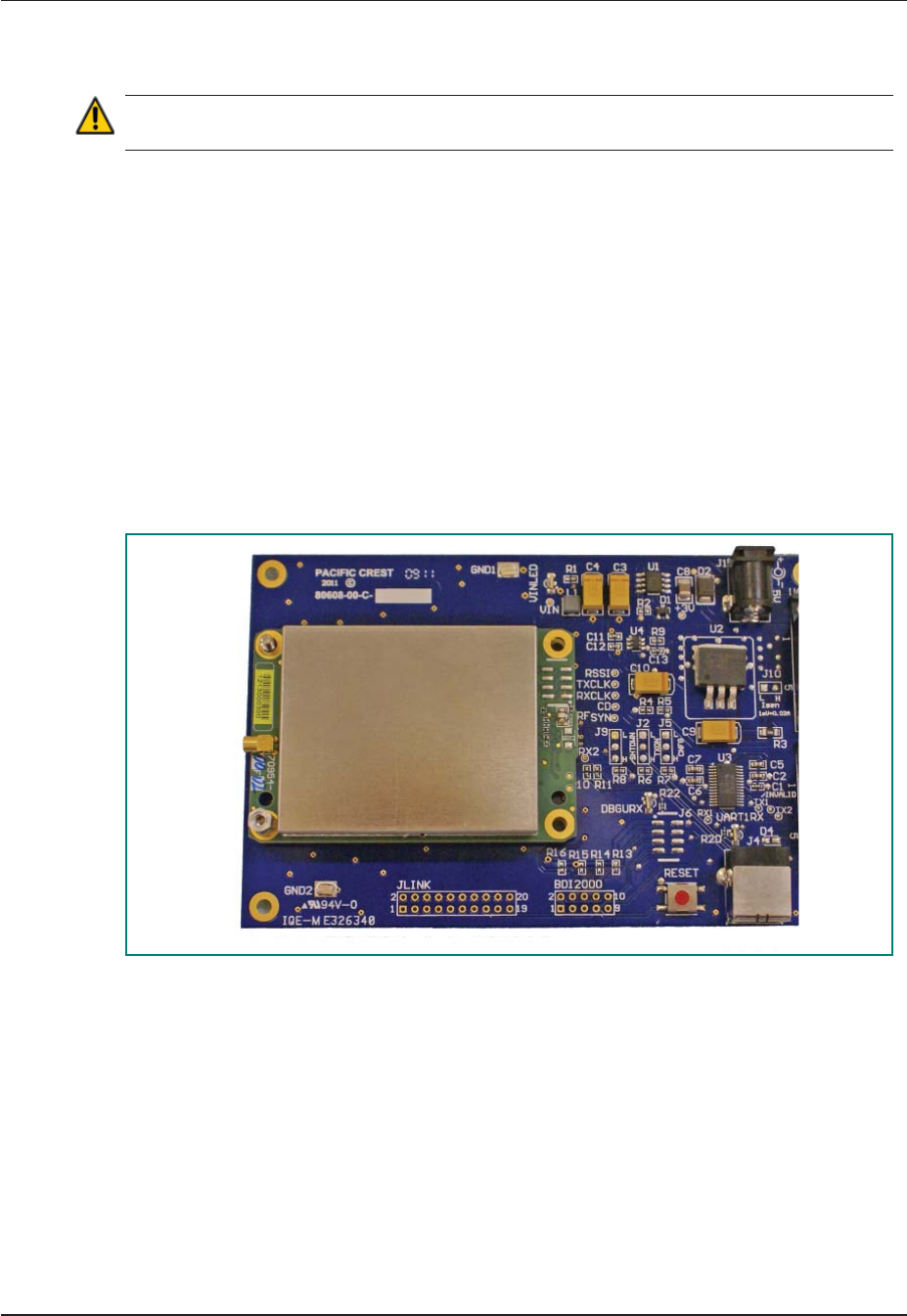
7XDL Micro Intergrator’s Guide
Getting Started
CAUTION – You must handle the XDL Micro transceiver with care during installation. Remove
the transceiver from its protective bag only in an ESD safe area.
To set up the hardware components:
1. Plug the transceiver into the 30-pin connector of an I/O-test board.
2. Attach an antenna to the transceiver using an XDL radio module pigtail data cable.
3. Attach a modem cable to a 9-pin RS232 connector on the I/O-test board.
4. Attach the modem cable to a serial port on the computer.
5. Attach a wall cable to the AC/DC adapter and then select the correct plug from the
adapter kit.
6. Attach the AD/DC adapter’s tubular plug to the power jack on the I/O-test board.
7. Install the XDLCONF software on the computer.
8. Start the XDLCONF software and then connect to the transceiver.
Figure 1 – XDL Micro in test board

8XDL Micro Intergrator’s Guide
Interface Port Pin Out
The standard XDL Micro transceiver comprises a 30-pin port for power, data, and
interfacing with other electronic devices. The following signals are available on the 30-pin
connector:
Pin number Function Description
1 GND Ground for signal and power
2 NC No Connection, Factory use only
3 TX Data Receives data from external device, 3 V CMOS (3.3 V
compatible)
4 NC No Connection, Factory use only
5 GND Ground for signal and power
6 NC No Connection, Factory use only
7 GND Ground for signal and power
8 NC No Connection, Factory use only
9 GND Ground for signal and power
10 NC No Connection, Factory use only
11 Configure No Connection, Factory use only
12 NC No Connection, Factory use only
13 NC No Connection, Factory use only
14 RX Data Sends data to external device, 3 V CMOS (3.3 V compatible)
15 NC No Connection, Factory use only
16 NC No Connection, Factory use only
17 NC No Connection, Factory use only
18 VCC Power In
19 GND Ground for signal and power
20 GND Ground for signal and power
21 GND Ground for signal and power
22 GND Ground for signal and power
23 VCC Power In
24 VCC Power In
25 VCC Power In
26 VCC Power In
27 VCC Power In
28 VCC Power In
29 Power Down Power down radio
30 GND Ground for signal and power
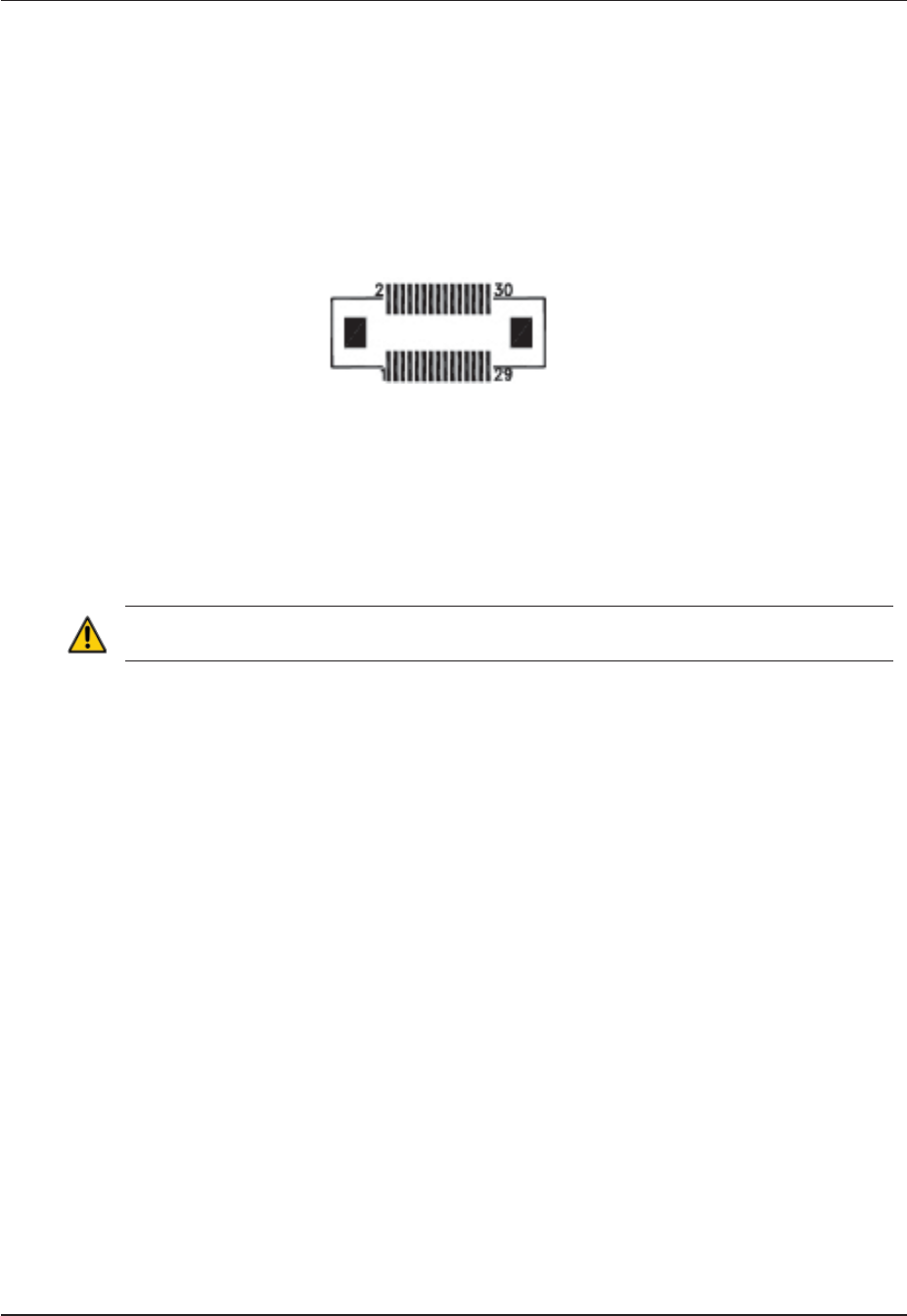
9XDL Micro Intergrator’s Guide
Transmit and receive pins
The XDL Micro module uses pin 3 to receive data from an external device, such as
a computer, GPS receiver, or weather sensor, and uses pin 14 to transmit data to the
external device.
The external device transmits data to the XDL Micro transceiver on pin 3, so according to
the DTE naming convention, pin 3 is called the Tx Data pin. The external device receives
data from pin 14 on the XDL Micro transceiver, so this is called the Rx Data pin.
Antenna port
A coaxial antenna port is provided to connect the antenna system to the transceiver. The
antenna connector is a 50-Ohm MMCX type. Appendix B: Cables and Connectors, page
17 provides part numbers and manufacturer information for compatible interface and
RF connectors. Pacific Crest also provides custom manufactured cables designed to your
specific needs. For specific cabling requirements, please contact us for a quotation.
CAUTION – Do not transmit without first connecting an antenna as it may damage the
transceiver.
Compatibility
The transceiver is compatible with most modes of operation supported by the XDL,
ADL and PDL product families of radio modems. For an overview of the protocols and
modes that the transceiver supports, see Protocols and Operation Modes, page 10. The
compatibility also extends to the XDLCONF configuration software and the XDL Test
application that are supplied as part of the XDL Micro Developer’s Kit (P/N 70888-88).

10 XDL Micro Intergrator’s Guide
Protocols and Operation Modes
You can completely configure the transceiver using the XDLCONF software. Configuration
parameters define the DTE interface and the over-the-air protocol. Depending on your
application, you may need to change the factory default settings.
The following table shows the factory default settings of the transceiver.
Setting Default setting
Channel 1
Baud Rate 38400
Parity None
Soft Break Disable Off
TX Power 0.5 W
Mode Transparent EOT Timeout
Link Rate 9600 bps GMSK
EOT 50 ms
Repeater Delay 0
CSMA On (CSMA is required to be on only in the U.S.A. You should turn off
CSMA in the European Union.)
FEC On
Scrambling On
Sensitivity High
Local Address 0
Destination address 255
Up to 32 frequencies are stored in the configuration memory called the channel table. The
selection of channels is subject to correct licensing of the corresponding frequencies by
the appropriate governmental agency. For instructions in creating and uploading channel
tables into the transceiver, refer to the XDLCONF User’s Guide.
The transceiver supports multiple protocols and modes of operation including:
• Transparent with EOT Timeout
• Transparent with EOT Character
• TRIMTALK II/IIe
• TRIMTALK 450S
• TRIMMARK 3
• SATEL
• South
• Stonex Type 1
• Transparent FST

11 XDL Micro Intergrator’s Guide
Electrical Considerations
Power supply
The transceiver has a power supply connection on pins 18, 23, 24, 25, 26, 27, and 28 of the
interface connector. If there is a potential for a ground path current loop due to incorrect
power application, Pacific Crest recommends that you insert a fusible link in the signal
ground to protect the transceiver.
The XDL Micro transceiver is designed to operate with an unregulated DC voltage level at
3.6 ±0.4V. The power supply must be capable of sourcing 2 A.
Data interface
The transceiver has one serial port. It is a data port that has a simple 3-wire CMOS
electrical interface with signals for transmitting data to, and receiving data from, the
transceiver, and for providing a reference ground for the Tx (pin 3) and Rx (pin 14) signals.
Note– Pacific Crest defines Tx and Rx as a DTE port. That is, an external device transmits
data to the radio modem’s Tx pin (pin 3) and receives data from the radio modem’s Rx pin
(pin 14).
CMOS input/output protection circuitry
The Tx signal terminates into a CMOS input port on the transceiver and should be driven
externally or pulled to ground through a 10 kΩ resistor. The absolute maximum voltage
applied to the Tx signal is -0.3 v to 3.3 V.
The Rx signal is CMOS outputs. Note that loading the RX signal increases the power
consumption of the transceiver and these should be limited to no more than 2.5 mA in
order to maintain performance across the temperature range.
CAUTION – Internal circuitry protects the inputs and outputs against damage caused by
high static voltages or electric fields. However, normal precautions are necessary to avoid
application of any voltage higher than the maximum-rated voltages.
NC pins
Pins 2, 4, 6, 8, 10, 12, 13, and 15 through 17 must be left with no connection.

12 XDL Micro Intergrator’s Guide
Power down pin
Pin 29 is the active low pin used to turn off power to the XDL Micro transceiver. The VIH
(Voltage Input High) minimum is 1.2 V and VIL (Voltage Input Low) maximum is 0.3 V. It
has a 10 K pull-up resistor to VCC. You can leave it unconnected (NC) if you do not want
to turn off the XDL Micro transceiver.
Error codes
The transceiver performs a variety of start-up and run-time tests to ensure optimal
operation. Tests include environmental as well as electrical measurements designed to
avoid damage to the unit while maintaining adequate operation.
A 50 Ω impedance coaxial MMCX style RF connector is provided to attach to an external
antenna system. The MMCX connector offers a positive friction locking mechanism that
is very reliable. In some circumstances it may be required to provide a physical stop to
prevent the MMCX plug from becoming disconnected due to extreme shock or vibration.
The transceiver requires an antenna and feed cable system that is impedance-matched
to 50 Ω. Pacific Crest recommends that you use a high-quality RG-178 or equivalent
coaxial cable for internal wiring of the RF signal from the MMCX connector to the panel
connector. Pacific Crest also recommends you select an antenna that has a low VSWR
(Voltage Standing Wave Ratio) (less than 1.5:1) and which is tuned for operation in the
band of the XDL Micro transceiver.
CAUTION – Incorrect impedance matching of the antenna, connectors, or cable degrades the
performance of the transceiver.
Shielding considerations
The transceiver is designed to operate in proximity to noise-generating circuitry.
However, certain radiated or conducted frequencies may degrade the performance of
the transceiver or make it inoperable. When possible, provide well-grounded shielding
between the transceiver and radiating circuits, such as power supplies, voltage-controlled
oscillators, and crystal oscillators.

13 XDL Micro Intergrator’s Guide
Frequency planning
The transceiver contains a very sensitive, dual-conversion, super-heterodyne receiver.
CAUTION – Radiated and conducted signals to and from the transceiver may cause problems
due to interference. Correct attention to frequency planning may reduce interference from
radiated or conducted frequencies that fall within the pass-bands of the filters at the IF
frequencies.
Pacific Crest recommends you first analyse the product frequency plan (including
harmonics) and then use a spectrum analyzer to determine the potential for interference
within the pass-bands of the various front-end and band pass filters.
The following table indicates the frequencies and pass-band filter characteristics that are
areas of potential interference.
Circuit Center frequency (MHz) Bandwidth (MHz)
RF front-end 438 70
First IF 54.45 0.015
Second IF 0.450 0.010

14 XDL Micro Intergrator’s Guide
Mechanical Considerations
EMI interferers
The transceiver is easily mounted in new and existing products. The transceiver is
specifically designed for operation in harsh environments. For best performance, mount
the radio away from potential EMI radiators and route RF signals apart from digital
signals.
CAUTION – To avoid interference between the signals, Pacific Crest recommends you do not
bundle the antenna interface cable with other signal cables internal to your product.
Shock and vibration
Sensitive receivers, such as that in the XDL Micro transceiver, are susceptible to
interference due to mechanical shock and vibration. To reduce the potential for
electromechanical interference, you must use a robust mounting scheme when you
integrate the transceiver into other systems. You may need to use a thin damping pad
between the mounting surface and the transceiver. Pacific Crest recommends that the
damping pads you use are made of PORON® or a similar material.
Thermal transfer
The transceiver requires additional thermal heat dissipation in order to supply maximum
output power at elevated ambient temperatures and high-duty cycles. The transceiver has
a thermal sensor and a firmware controlled limit switch. To prevent permanent damage
to the transmitter, the XDL Micro module shuts down when its internal temperature
reaches 85 °C (185 °F). The integrated heat sink is adequate for most bench top testing,
but when the transceiver is integrated into other systems you must consider additional
thermal heat sinking. The transceiver produces approximately 6 Watts of heat at full RF
power out.
For mounting diagrams and specification, see Appendix A: Mounting Guide, page 15.
Materials
The transceiver is housed in a metal shield that is a conductor and is electrically
connected to the ground and signal ground pins.
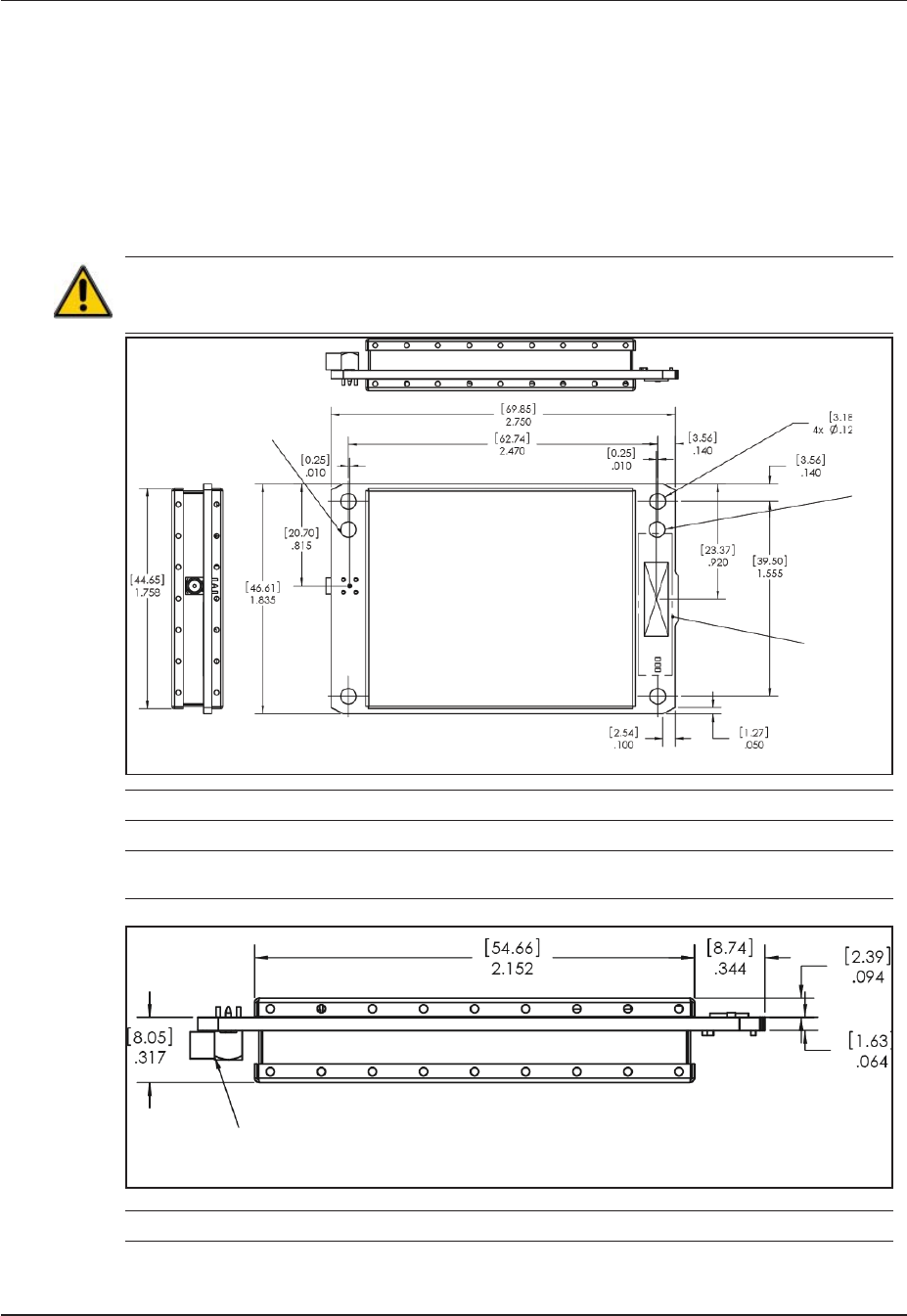
15 XDL Micro Intergrator’s Guide
Appendix A: Mounting Guide
Standard enclosure
The following figure shows mounting holes locations and overall dimensions for the
transceiver.
CAUTION – Screws used to mount the transceiver to a mounting plate must not penetrate
the mounting surface of the transceiver by more than 0.20 inches. Screws that penetrate
beyond this distance may cause damage.
❸
❶
❷
❶Test fixture tooling hole. Do not use for mounting.
❷Test fixture tooling hole. Do not use for mounting.
❸Keepout area both sides. Components and test points located here. .100 inch minimum
clearance.
❶
❶RF connector. Right angle MMCX.
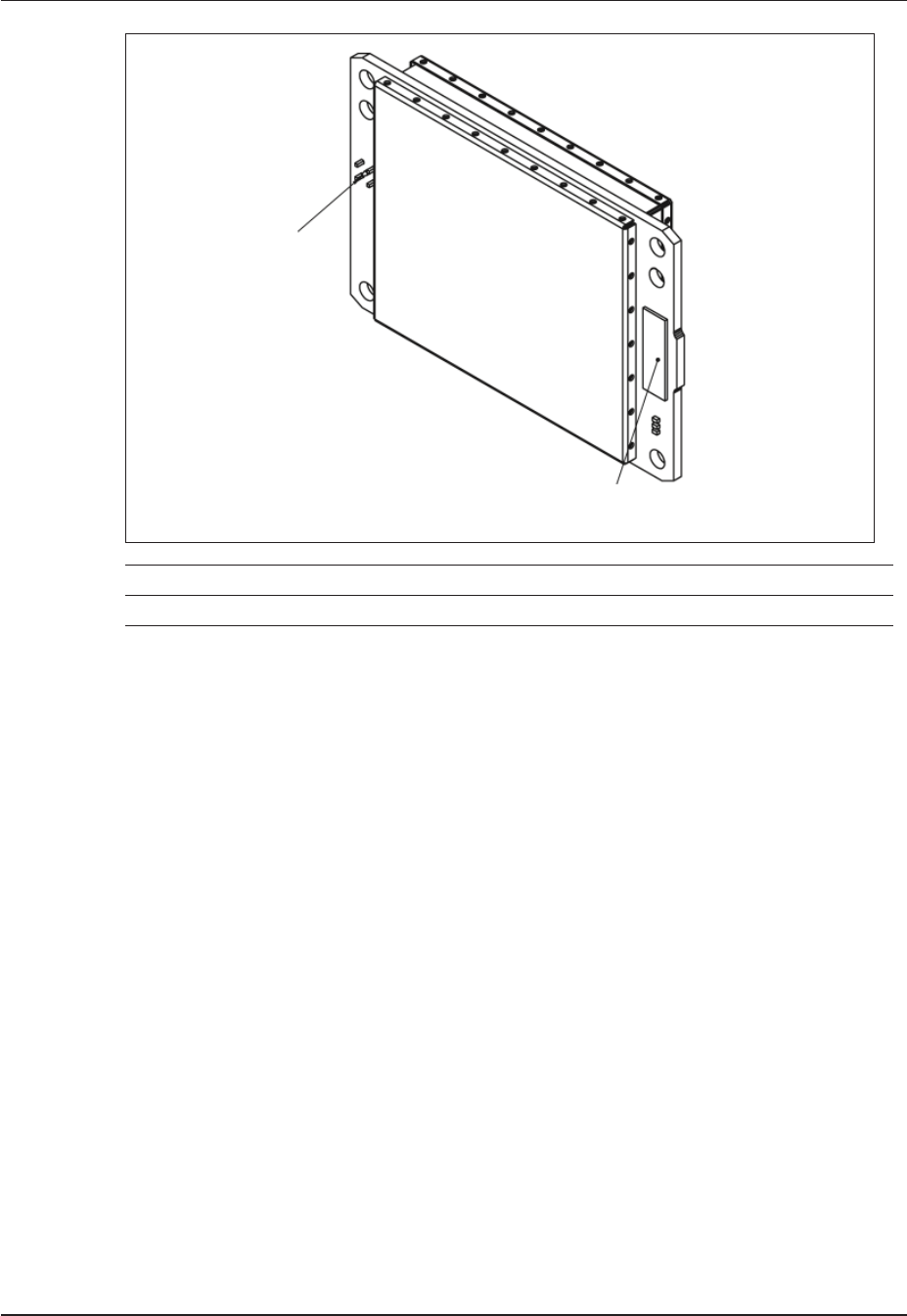
16 XDL Micro Intergrator’s Guide
❶RF connector. Right angle MMCX. Farside.
❷Data connector. AVX (Kyocera ELCO). Part number 14-5046-030-630-829+
❶
❷

17 XDL Micro Intergrator’s Guide
Appendix B: Cables and Connectors
Value-added cable products
Pacific Crest manufactures a wide variety of high-quality custom cables to support its
OEM customers. To discuss your custom cable requirements, contact your Pacific Crest
sales representative.
Interface connector
The 30-pin data/power header is an AVX Series 5046 fine-pitch connector, AVX part
number AVX 24-5046-030-630-829. The mating AVX connector is part number AVX
24-5046-030-600-829for a board-to-board interface that is coincident with the mounting
hardware.
RF connector
The RF connector is compatible with an MMCX-style coaxial plug. Plugs are available
from many sources and in many configurations. Pacific Crest uses plugs manufactured
by Radiall. Radiall MMCX right-angle plug for use with RG-178 cable is part number R110
172 100. Radiall MMCX straight plug for use with RG-178 cable is part number R110 083
120.

18 XDL Micro Intergrator’s Guide
Appendix C: Technical Specifications
General
DTE - DCE interface CMOS, 115.2 kbps maximum
Power requirements
External 3.6 VDC ± 0.05mV
During Rx 0.45 W nominal @ 3.6 VDC
During Tx 6.5 W nominal @ 3.6 VDC, 2 W RF output
Radio
Frequency band 403-473 MHz
Frequency control Synthesized 12.5 kHz tuning resolution
Frequency stability +/- 1PPM
Channel spacing Channel spacing 12.5/25 kHz (user-selectable)
RF transmitter output 0.5, 1.0 or 2 Watt (Programmable)
Sensitivity -110 dBm BER = 1 x 10-5
Adjacent channel
selectivity
>50dB
Type certification All models will be type accepted and certified for operation in the
U.S., Europe, Australia, New Zealand, and Canada
FCC, IC, EU, NZ, Australia ETS300-113-2
Modem
Link Rate/Modulation 4-Level FSK: 9600, 19,200 bps
GMSK: 4800, 8000, 9600, 16,000, 19,200 bps
Link Protocols Transparent EOT/EOC/FST, SATEL, South, Stonex Type 1, TRIMTALK II/
IIe, TRIMMARK3, TRIMTALK 450S
Forward Error Correction
(FEC) and Detection
Yes
Environmental
Shock and vibration Per MIL-STD-810F
Ambient temperature
range
Operating temperature
(receiver)
-40 ˚C to +85 ˚C (-40 ˚F to +185 ˚F)
Operating temperature
(transmitter)
-40 ˚C to +65 ˚C (-22 ˚F to +149 ˚F)
Storage temperature -55 ˚C to +85 ˚C (-67 ˚F to +185 ˚F)
Mechanical
Dimensions 69.8 mm L x 46.6 mm W x 11.2 mm H
2.750” L x 1.835” W x 0.442” H
Weight 1.4 oz (40 grams)

19 XDL Micro Intergrator’s Guide
Appendix D: API Commands
A description of the XDL Micro transceiver Application Programmer Interface is
available to qualified Pacific Crest development partners. Please contact sales@
PacificCrest.com.